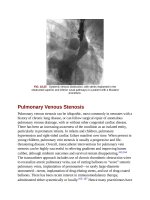Andersons pediatric cardiology 543
Bạn đang xem bản rút gọn của tài liệu. Xem và tải ngay bản đầy đủ của tài liệu tại đây (102.27 KB, 3 trang )
FIG.22.14 Rhythmstripfroma4-month-oldwithanarrowcomplex
supraventriculartachycardia(SVT)breakingthroughonflecainideand
propranolol.TherateoftheSVTis190beats/min.Thetachycardiabroke
asanintravenouslinewasbeingplaced.Thearrowshowsthefirstsinus
beat.TheabruptterminationoftheSVTisconsistentwithareentranttype
ofarrhythmia.
NaturalHistoryofNeonatal/Infant
SupraventricularTachycardia
AlthoughepisodesofSVTarecommonduringinfancy,mostpatientsarefreeof
tachycardiaduringearlychildhood,althoughsomeinfantsdonothavea
recurrenceofSVTaftertheinitialpresentation.65Naturalhistorystudieshave
suggestedthatapproximately30%ofinfantsloseSVTinducibilityby1yearof
age.66Factorsatpresentation,characteristicsofthetachycardia,ordatafroman
initialesophagealEPSfailedtopredictwhichinfantswouldhavecontinuedSVT
recurrencesandthusrequireantiarrhythmicmedicationandwhichinfantswould
notneedmedication.62However,allinfantswiththediagnosisofAVNRT
continuedtohaveinducibleSVTat1yearofage.Mostinfantsarefreeof
medicationsat1yearofage.
MedicalManagementofSupraventricular
Tachycardia
Theuseofchronicantiarrhythmicmedicationsintheinfantmayprevent
recurrentSVTeventsandallowthetimeneededforSVTresolution.Therehave
beenfewclinicaltrialstodirectchronicSVTmanagementinchildren,andthe
choiceofantiarrhythmicmedicationsisoftenbasedonpersonalpreferenceand
institutionalpracticeasopposedtodatafromcontrolledclinicaltrials.Inthefirst
randomizedcontrolledtrialofmedicalprophylaxisforSVTinapediatric
population,theresearchersdetectednodifferencesinSVTrecurrencebetween
digoxinandpropranolol,thetwomostcommonclinicalchoicesforSVT
prophylaxisininfants.67AlowSVTrecurrenceratewasseeninbothgroups.In
thisstudy,allrecurrenceswereseeninthefirstfewweeksoflife,andthe
majorityofpatientswerearrhythmiafreeat4monthsofage.Currentlyitis
standardpracticetouseprophylacticmedicationfor6to12months,butthis
durationoftherapymaynotbenecessary.Bothdigoxinandpropranolol
representareasonablefirst-linechoicefortheneonatewithSVT.However,if
WPWsyndromeispresent,digoxinisnotrecommendedowingtoreportsthat
thiscanshortentheeffectiverefractoryperiodoftheaccessoryconnection.68In
anolderchildaβ-blockerwithtwicedailydosingmaybepreferableand
atenololisareasonablefirst-lineagent.
Decisionsconcerningtheneedforotherantiarrhythmicagentsdependonthe
tachycardiaburdenandsymptoms,coexistingstructuralandfunctionalheart
disease,personalexperience,andinstitutionalpractice.Numerousagentsexist,
althoughfewhavehadrigoroustestinginapediatricpopulation.
CatheterAblationofSupraventricular
Tachycardia
Decisionsareoftenbasedoninputfromthepatientandfamily.Pediatriccatheter
ablationindicationswereassessedintwolargepediatricstudies,andthemost
commonindicationforcatheterablationwaspatientandparentwishes.69,70
ChildrenwithWPWsyndromearedifferent.Becausethisconditionis
associatedwithasmallriskofsuddendeath,thereshouldbealowthresholdfor
ablationinthispopulation,withpatientageandsizefactoredintothedecision.
Animalstudiessuggestlesiongrowthwhenablationsareundertakenin
immatureanimals,andriskshavebeenshowntobeincreasedinchildren
weighinglessthan15kg.71,72Postponinganablationallowstimeforsubstrate
resolutionaswellasthepatient'ssomaticgrowth,whichcandecreasetheriskof
theprocedure.Ablationisnotwithoutrisk,buttheriskissmall.Thusthesmall
andimmediateriskoftheablationmustbeweighedagainstthelifetime
symptomburden,easeofSVTmanagement,and—inchildrenwithWPW
syndrome—thelifetimeriskofsuddendeath.
PermanentFormofJunctionalReciprocating
Tachycardia
PJRTisanaccessorypathway–mediatedtachycardiawithalongRPinterval;it
occurspredominantlyininfantsandchildren(Fig.22.15).Thepathwaycanbe
locatedanywhereintheAVjunctionbutisusuallylocatedintheposteroseptal
region.ThisisatachycardiawithalongVAinterval,calledalongRP′
tachycardia.ThetypicalECGofPJRTisthatofnegativePwavesinleadsII,III,
aVF,giventhetypicalinferiorlocationofthisuniqueaccessorypathway.
BecausetheAVnodeconstitutestheanterogradelimbofthistachycardia,itwill
likelyterminatewithadenosine;mostoften,however,itquicklyrecurs.
Pathwaysaretortuousandslowconducting;thusthetachycardiaisoften
incessant,andPJRTisthesecondmostcommoncauseofarrhythmia-induced
cardiomyopathyinchildren.73InalargereviewofchildrenwithPJRT,27%
presentedinfetallife,7%ofthesewithhydrops,whichisafetalmanifestation
ofarrhythmia-inducedcardiomyopathy.74IsolationoftheAVjunctionisa
continuingprocessthatmaynotbecompleteatbirth,andthepresenceof
accessoryconnectionscrossingtheannulusfibrosuscouldresultinpersistent
perinatalSVT.AlthoughmostchildrenwithPJRTpresentwithpalpitationsor
arenotedtohaverapidheartrates,inthisseriesof194children,18%presented
withcardiomyopathy.74Cardiomyopathywasmorelikelytooccurinchildren
withlongerRPinterval/cyclelengthratios,consistentwithanaccessorypathway
withslowretrogradeconductionandawide,excitablegap.PJRTisoften
incessant,andthosewithincessantPJRThadlongerRPintervals,wereyounger
atdiagnosis,andmoreoftenhadcardiomyopathy.TheclinicalcourseofPJRTis
notbenignandspontaneousresolutionisunlikely.









